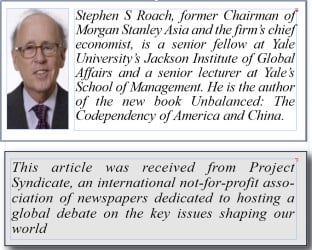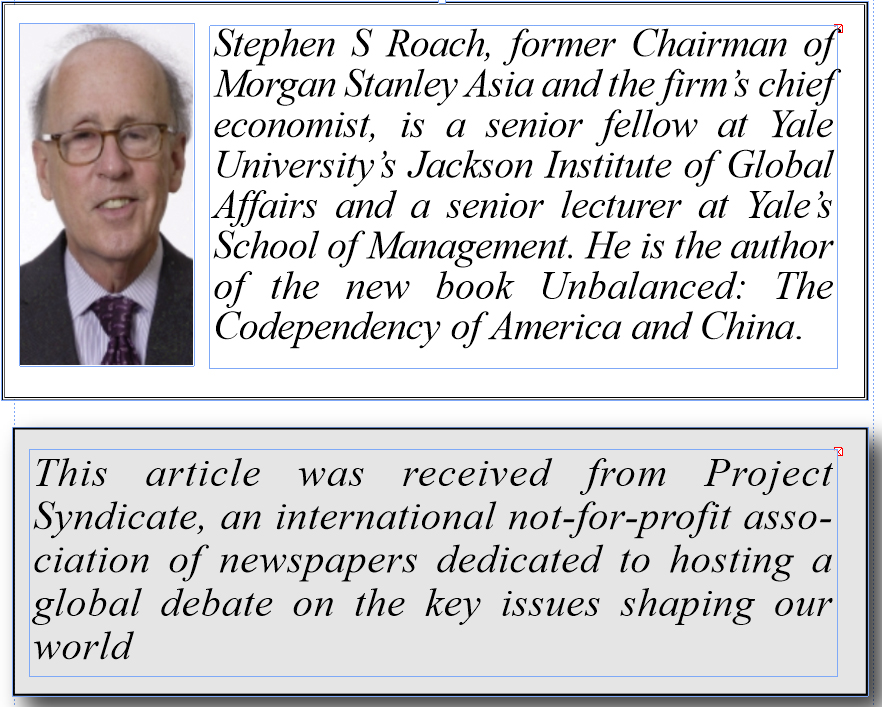By Stephen S Roach
NEW HAVEN – Market manipulation has become standard operating procedure in policy circles around the world. All eyes are now on China’s attempts to cope with the collapse of a major equity bubble. But the efforts of Chinese authorities are hardly unique. The leading economies of the West are doing pretty much the same thing – just dressing up their manipulation in different clothes.
 Take quantitative easing, first used in Japan in the early 2000s, then in the United States after 2008, then in Japan again beginning in 2013, and now in Europe. In all of these cases, QE essentially has been an aggressive effort to manipulate asset prices. It works primarily through direct central-bank purchases of long-dated sovereign securities, thereby reducing long-term interest rates, which, in turn, makes equities more attractive.
Take quantitative easing, first used in Japan in the early 2000s, then in the United States after 2008, then in Japan again beginning in 2013, and now in Europe. In all of these cases, QE essentially has been an aggressive effort to manipulate asset prices. It works primarily through direct central-bank purchases of long-dated sovereign securities, thereby reducing long-term interest rates, which, in turn, makes equities more attractive.
Whether the QE strain of market manipulation has accomplished its objective – to provide stimulus to crisis-torn, asset-dependent economies – is debatable: Current recoveries in the developed world, after all, have been unusually anemic. But that has not stopped the authorities from trying.
In their defense, central banks make the unsubstantiated claim that things would have been much worse had they not pursued QE. But, with now-frothy manipulated asset markets posing new risks of financial instability, the jury is out on that point as well.
China’s efforts at market manipulation are no less blatant. In response to a 31% plunge in the CSI 300 (a composite index of shares on the Shanghai and Shenzhen exchanges) from its June 12 peak, following a 145% surge in the preceding 12 months, Chinese regulators have moved aggressively to contain the damage.
Official actions run the gamut, including a $480 billion government-supported equity-market backstop under the auspices of the China Securities Finance Corporation, a $19 billion pool from major domestic brokerages, and an open-ended promise by the People’s Bank of China (PBOC) to use its balance sheet to shore up equity prices. Moreover, trading was suspended for about 50% of listed securities (more than 1,400 of 2,800 stocks).
Unlike the West’s QE-enabled market manipulation, which works circuitously through central-bank liquidity injections, the Chinese version is targeted more directly at the market in distress – in this case, equities. Significantly, QE is very much a reactive approach – aimed at sparking revival in distressed markets and economies after they have collapsed. The more proactive Chinese approach is the policy equivalent of attempting to catch a falling knife – arresting a market in free-fall.
There are several other noteworthy distinctions between China’s market manipulation and that seen in the West. First, Chinese authorities appear less focused on systemic risks to the real economy. That makes sense, given that wealth effects are significantly smaller in China, where private consumption accounts for just 36% of GDP – only about half the share in more wealth-dependent economies like the US.
Moreover, much of the sharp appreciation in Chinese equity values was very short-lived. Nearly 90% of the 12-month surge in the CSI 300 was concentrated in the seven months following the start of cross-border investment flows via the so-called Shanghai-Hong Kong Connect in November 2014. As a result, speculators had little time to let the capital gains sink in and have a lasting impact on lifestyle expectations.
Second, in the West, post-crisis reforms typically have been tactical, aimed at repairing flaws in established markets, rather than promoting new markets. In China, by contrast, post-bubble reforms have a more strategic focus, given that the equity-market distress has important implications for the government’s capital-market reforms, which are viewed as crucial to its strategy of structural rebalancing. Long saddled with a bank-centric system of credit intermediation, the development of secure and stable equity and bond markets is a high priority in China’s effort to promote a more diversified business-funding platform. The collapse of the equity bubble calls that effort into serious question.
Finally, by emphasizing a regulatory fix, and thereby keeping its benchmark policy rate well above the dreaded zero bound, the PBOC is actually better positioned than other central banks to maintain control over monetary policy and not become ensnared in the open-ended provision of liquidity that is so addictive for frothy markets. And, unlike in the West, China’s targeted equity-specific actions minimize the risk of financial contagion caused by liquidity spillovers into other asset markets.
With a large portion of China’s domestic equity market still closed, it is hard to know when the correction’s animal spirits have been exhausted. While the government has assembled considerable firepower to limit the unwinding of a spectacular bubble, the overhang of highly leveraged speculative demand is disconcerting. Indeed, in the 12 months ending in June, margin financing of stock purchases nearly tripled as a share of tradable domestic-equity-market capitalization.
While Chinese equities initially bounced 14% off their July 8 low, the 8.5% plunge on July 27 suggests that that may have been a temporary respite. The likelihood of forced deleveraging of margin calls underscores the potential for a further slide once full trading resumes.
More broadly, just as in Japan, the US, and Europe, there can be no mistaking what prompted China’s manipulation: the perils of outsize asset bubbles. Time and again, regulators and policymakers – to say nothing of political leaders – have been asleep at the switch in condoning market excesses. In a globalized world where labor income is under constant pressure, the siren song of asset markets as a growth elixir is far too tempting for the body politic to resist.
Speculative bubbles are the visible manifestation of that temptation. As the bubbles burst – and they always do – false prosperity is exposed and the defensive tactics of market manipulation become both urgent and seemingly logical.
Therein lies the great irony of manipulation: The more we depend on markets, the less we trust them. Needless to say, that is a far cry from the “invisible hand” on which the efficacy of markets rests. We claim, as Adam Smith did, that impersonal markets ensure the most efficient allocation of scarce capital; but what we really want are markets that operate only on our terms.

